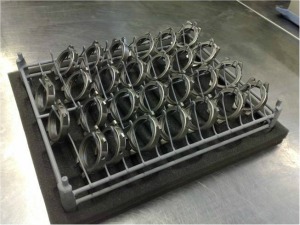How to Position Parts in an Ultrasonic Cleaner

Correct parts positioning in an ultrasonic cleaner is as important as the ultrasonic cleaning frequency and ultrasonic cleaning solution formulation. Yet of these three criteria improper parts positioning is often the cause of unsatisfactory results or extended time in the cleaning solution.
Don’t Fight Cavitation
Better said, don’t impede cavitation action. Cleaning is accomplished by the violent implosion of minute bubbles created in the cleaning solution by ultrasonic transducers. The cleaning action occurs on all surfaces wetted by the solution as sound waves migrate upward through the solution from the bottom of the ultrasonic cleaner tank and reflect back down from the solution surface. This suggests that putting too much product in the cleaning baskets is not a good idea because it will impede sound reflection. At Tovatech we recommend a 1 to 2 inch space between the tank walls and parts in the basket.
Related to this, strive to keep parts from contacting each other in the bath. The contact area will not receive the full benefit of cavitation action. If this proves impractical reposition the parts during the cleaning cycle.
Another property of ultrasonic cavitation is that it occurs more efficiently on surfaces facing and closer to the bottom of the tank. Gentle vertical agitation during cleaning always helps. In addition you’ll find you’ll get improved cleaning, especially on larger parts, if they are periodically repositioned in the basket. Remember to do this by removing the basket from the bath or by using special tools. Don’t reach into an ultrasonic cleaning bath while it is operating. Parts with many openings will clean more uniformly than large solid parts as sound waves can pass through the openings.
Cleaning action on small parts processed in bulk occurs best near the bottom and the top of the cleaning bath, the latter due to the aforementioned reflection. We recommend considering a rotating basket if the parts are not sensitive to scratching. Keep in mind that small parts rotating in a liquid are generally not damaged. If you are uncertain run a few tests and examine the parts after the cleaning cycle.
Be certain that blind holes are positioned in such a way that surfaces are wetted by the solution. When cleaning metal tubes ultrasound will pass through the walls. The cleaning solution must be inside. Moving tubes in and out of the cleaning solution helps because the tubes will keep filling with fresh solution.
Other Parts Positioning Points to Ponder
- Automotive fuel injector components are costly and sensitive. They should be fixed in position in coated baskets for rotation.
- The mass of the parts has no effect on the cleaning effectiveness and speed.
- The best position for PCBs and tubes is vertical. A diagonal fit is acceptable.
- Small diameter tubes may introduce rinsing challenges because in the absence of surfactant the tubes may not fill easily. Rinsing will be effective only if the tubes fill.
Other Ultrasonic Cleaning Resources
Up front we mentioned two other considerations important to quality ultrasonic cleaning. Check our posts on ultrasonic cleaning frequencies and ultrasonic cleaning solutions.
And contact the ultrasonic cleaning scientists at Tovatech for professional advice on all aspects of ultrasonic cleaning.
